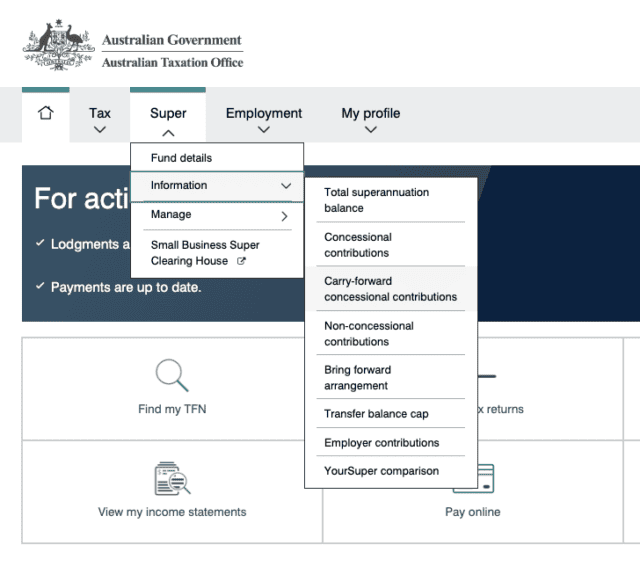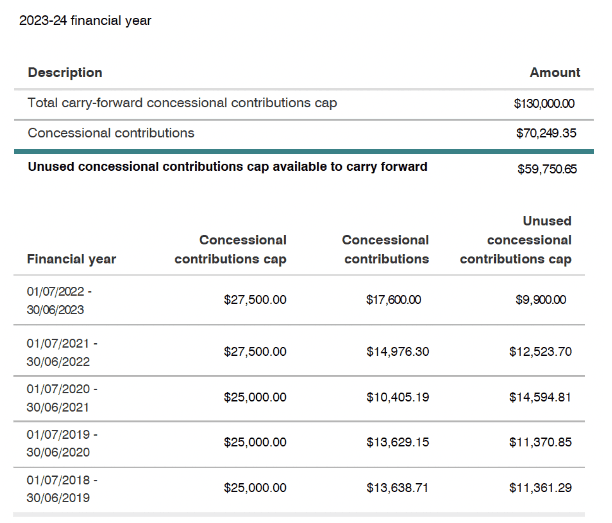For years, superannuation contributions were a ‘use it or lose it’ opportunity. If you didn’t max out your annual limits, you couldn’t make up for it later. But changes a few years ago have opened up new avenues to boost your super. Read on to see how you can use carry-forward concessional contributions can be used to save you tax and boost your super.
One game-changing reform is the ability to roll over unused concessional (before-tax) contribution limits into future years for up to five years. This started in July 2018, allowing you to catch up on missed opportunities.
Carry-forward concessional contributions – how they work:
– The concessional cap includes super guarantee payments from your employer plus any salary sacrificed amounts.
– If your total concessional contributions in a year are below the cap (e.g. $27,500 from 2022 onwards), you can contribute the unused portion in subsequent years on top of that year’s limit.
– However, your total super balance must have been below $500,000 as of June 30 of the previous year.
The 2024 financial year is significant because unused caps from 2019 will expire on the 30th of June 2024. Theoretically, if you haven’t maxed out concessional contributions since 2019, you could contribute up to $152,500 this year and claim a massive tax deduction..
Let’s look at an example:
Say you made the following concessional contributions:
– 2019: $13,639
– 2020: $13,629
– 2021: $10,405
– 2022: $14,976
– 2023: $17,600
Your unused caps would be:
– 2019: $11,361 ($25,000 – $13,639)
– 2020: $11,371 ($25,000 – $13,629)
– 2021: $14,595 ($25,000 – $10,405)
– 2022: $12,524 ($27,500 – $14,976)
– 2023: $9,900 ($27,500 – $17,600)
In the 2024 financial year, you could contribute up to $59,751 ($11,361 + $11,371 + $14,595 + $12,524 + $9,900) on top of your standard $27,500 2024 cap.
This strategy provides significant tax savings and a super boost. Even if your total super was just under $500,000 on June 30, 2023, you can still use the full catch-up amount.
Another important change that happened in 2017 is that anyone with employment income can make personal deductible contributions, removing the old 10% income test.
These reforms make it easier than ever to maximise your super. But consider the caps, the proposed $3 million balance limit for tax concessions from 2025, and access restrictions before contributing.
How to calculate your unused concessional contributions
To determine your unused concessional contributions from prior years via your myGov account linked to the ATO, follow these steps:
- Log into your myGov account and navigate to the ATO services section.
- Under the ‘Super’ heading, select ‘Information & Details’, then click on ‘Carry-forward concessional contributions’.

- This will show you a summary of your unused concessional contributions and a detailed breakdown per year.

Importantly, it will not include contributions for the current financial year.
To determine the total amount of additional concessional contributions you can make before 30 June 2024, you will need to do the following calculation:
- $27,500 less the total current year (2023/24) concessional contributions made (or that will be made before 30/06/2024);
- This will give you your unused amounts for the current financial year;
- Add the current year’s expected unused concessional contribution amount to the prior year’s unused concessional contributions to get the total additional contributions you can make.
Example:
- Your employer contributed $17,500 to your super fund during the 2023/24 financial year, so you have $10,000 available in your current-year cap to increase it to $27,500.
- Your prior year’s unused concessional contributions carry forward amount is $59,751.
- The total amount of additional concessional contributions you can make is $10,000 + $59,751 = $69,751.
Also, remember that your Total Super Balance as of 30 June 2023 must be under $500,000 to enable you to use the catch-up contributions. Even if your super balance at the time of contributing is over $500,000, you are still eligible because it’s based on your balance as of 30 June of the previous financial year.
Unused Concessional Contributions Calculator
What is the process to make a carry forward concessional contribution into an SMSF
Here is a summary of the process for making a concessional contribution to a self-managed super fund (SMSF):
- Deposit the contribution amount into the SMSF’s bank account. Ensure the deposit reference clearly identifies it is a concessional contribution.
- Complete the ATO’s ‘Notice of intent to claim or vary a deduction for personal super contributions’ form (NAT 71121). This notifies the ATO you intend to claim a tax deduction for the contribution.
- The notice must be submitted to the SMSF trustees before the earlier of:
– The day you lodge your personal income tax return
– The end of the income year following the year the contribution was made
- The SMSF trustees must acknowledge the notice by providing you with a written confirmation notice.
- Once you receive the trustees’ confirmation, you can claim a tax deduction for the contribution amount on your personal income tax return for that financial year.
- The SMSF will include the contribution as part of its taxable income when it lodges its annual tax return.
By following this process, concessional contributions to an SMSF can provide an upfront tax deduction while boosting retirement savings in a concessionally taxed environment.
I’m self-employed via a company (or trust). What’s the process for making additional concessional contributions?
If you are self-employed and operate your own company, the process for making additional concessional contributions to your SMSF is:
- Your company makes the contributions on your behalf from its income or cash reserves. These are treated as tax-deductible business expenses for the company.
- The contributions can be made either as:
– Employer contributions under the superannuation guarantee rules, or
– Additional salary sacrifice contributions above the 9.5% super guarantee amount
- To make salary sacrifice contributions, you need to set up an effective salary sacrifice arrangement with your company. This involves reducing your cash salary by the amount you want to contribute, with your company then contributing that amount to your SMSF.
- All contributions made by your company on your behalf count towards your annual concessional contribution cap ($27,500 for 2023/24).
- Your company claims a tax deduction for the total contributions made on your behalf in its own tax return for that income year.
- The SMSF will include the contribution as part of its taxable income when it lodges its annual tax return.
Make your contributions early to avoid missing the deadline
It is crucial to make extra concessional contributions to a self-managed super fund (SMSF) well before June 30, 2024, because June 30 falls on a Sunday this year. Contributions must be received by the SMSF’s bank account no later than June 30 to count towards the 2023-24 financial year.
Since most banks do not process transfers on weekends or public holidays, the effective cut-off date will likely be Thursday, June 27, 2024. Any contributions made after this date risk not being credited to the SMSF’s account until the next business day of July 1, 2024, meaning they count towards the 2024-25 year instead.
To avoid missing out on claiming a tax deduction for 2023-24 or using up carried-forward unused cap amounts before they expire on June 30, 2024, it is prudent for SMSF trustees to initiate any final 2023-24 concessional contribution transfers at least 2-3 business days before the June 27 cut-off. This allows sufficient time for the funds to clear and be received into the SMSF’s bank account by June 30.
Use it or lose it!
The ability to carry forward unused concessional contribution caps opens up significant tax planning opportunities, especially in the lead-up to June 30, 2024, when the first unused cap amounts from 2018/19 expire.
You can claim a larger tax deduction while boosting retirement savings by making additional concessional contributions up to the $27,500 cap plus any carried forward amounts. This strategy is particularly powerful for those with higher incomes or looking to reduce capital gains tax liabilities.
However, it requires carefully tracking contribution caps, factoring in the $500,000 total super balance test, and ensuring contributions are received by the cut-off date. With proactive planning and advice from a qualified professional, catch-up concessional contributions provide a valuable way to supercharge your super.
